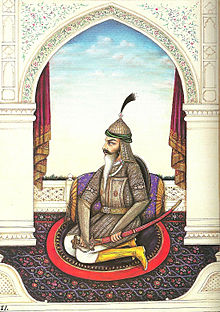Hari Singh Nalwa
| Sardar Hari Singh Nalwa | |
|---|---|

"Hari Singh Nalwa seated in full armour and adopting a military stance"-copy of a native painting by Sir John Mcqueen
|
|
| Native name | ਹਰੀ ਸਿੰਘ ਨਲੂਆ |
| Nickname(s) |
|
| Born | 1791 Gujranwala, Sikh Confederacy |
| Died | 1837 (aged 45–46) Jamrud, Sikh Empire |
| Allegiance |
|
| Service/branch | Sikh Khalsa Army |
| Years of service | 1804–1837 |
| Rank |
|
| Commands held | |
| Battles/wars | Battle of Kasur (1807), (1813), Battle of Multan (1818), Battle of Shopian (1819), Battle of Mangal (1821), Battle of Mankera (1821), Battle of Nowshera (1823), Battle of Sirikot (1824), Battle of Saidu (1827), Battle of Peshawar (1834) Battle of Jamrud (1837) |
| Awards | Izazi-i-Sardari |
| Relations |
|
Hari Singh Nalwa (Nalua) (1791–1837) was Commander-in-chief of the Sikh Khalsa Army, the army of the Sikh Empire. He is known for his role in the conquests of Kasur, Sialkot, , Multan, Kashmir, Peshawar and Jamrud. He is also the founder of Haripur city in Pakistan, which is named after him.
Hari Singh Nalwa was responsible for expanding the frontier of Sikh Empire to beyond the Indus River right up to the mouth of the Khyber Pass. In 1831, he opposed moves by Ranjit Singh to appoint Kharak Singh as his successor as Maharaja of the Sikh Empire. At the time of his death, the western boundary of the empire was Jamrud.
He served as governor of Kashmir, Peshawar and Hazara. He established a mint on behalf of the Sikh Empire to facilitate revenue collection in Kashmir and Peshawar.
Hari Singh Nalwa was born in Gujranwala, in the Majha region of Punjab to Gurdas Singh Uppal and Dharam Kaur Uppal. After his father died in 1798, he was raised by his mother. In 1801, at the age of ten, he took Amrit Sanchar and was baptised as a Sikh. At the age of twelve, he began to manage his father's estate and took up horse riding.
In 1804, at the age of fourteen, his mother sent him to the court of Ranjit Singh to resolve a property dispute. Ranjit Singh decided the arbitration in his favour because of his background and aptitude. Hari Singh had explained that his father and grandfather had served under Maha Singh and Charat Singh, the Maharaja's ancestors, and demonstrated his skills as horseman and musketeer. Ranjit Singh gave him a position at the court as a personal attendant.
...
Wikipedia
